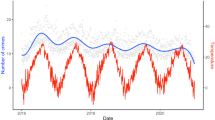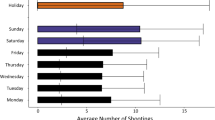Abstract
Previous studies investigating the relation between heat stress and crime incidents often focus on violent crimes. In this study, the impacts of heat stress on two types of robbery (violent and nonviolent) in China are compared using crime statistics collected in Beijing and heat stress indices that consider the combined effects of temperature and humidity. The results indicate that the abrupt change in the trend of robbery rates is affected by the 2008 Beijing Olympic Games. The nonviolent robbery rates have a more pronounced seasonality and are better correlated with heat stress at daily scales, especially during the period from 2009 to 2014 when no trend exists. The results also demonstrate that both violent and nonviolent robbery rates significantly increase with heat stress in spring. The nonviolent robbery rates also significantly increase with heat stress in summer. The influence of heat stress on violent robbery rate is more complicated and nonlinear.






Similar content being viewed by others
References
ACSM (1984) Position stand on the prevention of thermal injuries during distance running. Med J Aust 141:876–879
Barnett J, Adger WN (2007) Climate change, human security and violent conflict. Polit Geogr 26:639–655
Bell PA (1992) In defense of the negative affect escape model of heat and aggression. Psychol Bull 111:342–346
Bernauer T, Bohmelt T, Koubi V (2012) Environmental changes and violent conflict. Environ Res Lett 7:015601
Brunsdon C, Corcoran J, Higgs G, Ware A (2009) The influence of weather on local geographical patterns of police calls for service. Environ Plann B 36:906–926
Burke MB, Miguel E, Satyanath S, Dykema JA, Lobell DB (2009) Warming increases the risk of civil war in Africa. Proc Natl Acad Sci USA 106:20670–20674
Buzan JR, Oleson K, Huber M (2015) Implementation and comparison of a suite of heat stress metrics within the Community Land Model version 4.5. Geosci Model Dev 8:151–170
Chen P, Shu XM, Yuan HY, Li DS (2011) Assessing temporal and weather influences on property crime in Beijing, China. Crime Law Soc Ch 55:1–13
Cohen LE, Felson M (1979) Social change and crime rate trends: a routine activity approach. Am Sociol Rev 44:588–608
Cohn EG, Rotton J (2000) Weather, seasonal trends and property crimes in MINNEAPOLIS 1987–1988: a moderator-variable time-series analysis of routine activities. J Environ Psychol 20:257–272
Field S (1992) The effect of temperature on crime. Br J Criminol 32:340–351
Fischer EM, Oleson KW, Lawrence DM (2012) Contrasting urban and rural heat stress responses to climate change. Geophys Res Lett 39:419–420
Gamble JL, Hess JJ (2012) Temperature and violent crime in Dallas, Texas: relationships and implications of climate change. West J Emerg Med 8:239–246
Horrocks J, Menclova A (2011) The effects of weather on crime. N Z Econ Papers 45:231–254
Hsiang SM, Meng KC, Cane MA (2011) Civil conflicts are associated with the global climate. Nature 476:438–441
Hsiang SM, Burke M, Miguel E (2013) Quantifying the influence of climate on human conflict. Science 341, 1212-+
Ingram DL (1965) Evaporative cooling in the pig. Nature 207:415–416
Jacob B, Lefgren L, Moretti E (2006) The dynamics of criminal behavior: evidence from Weather Shocks. J Hum Res 42:489–527
Mares D (2013) Climate change and levels of violence in socially disadvantaged neighborhood groups. J Urban Health 90:768–783
Masterson JM, Richardson FA (1979) Humidex, a method of quantifying human discomfort due to excessive heat and humidity. Environment Canada, Atmospheric Environment Service, Downsview, Ontario, CLI
Mehluma H, Miguel E, Torvik R (2006) Poverty and crime in 19th century Germany. J Urban Econ 59:370–388
Miguel E (2005) Poverty and witch killing. Rev Econ Stud 72:1153–1172
Oleson KW, Monaghan A, Wilhelmi O, Barlage M, Brunsell N, Feddema J, Hu L, Steinhoff DF (2015) Interactions between urbanization, heat stress, and climate change. Clim Change 129:525–541
O’Loughlin J, Witmer FDW, Linke AM, Laing A, Gettelman A, Dudhia J (2012) Climate variability and conflict risk in East Africa, 1990–2009. Proc Natl Acad Sci USA 109:18344–18349
Ranson M (2014) Crime, weather, and climate change. J Environ Econ Manag 67:274–302
Scheffran J, Brzoska M, Kominek J, Link PM, Schilling J (2012) Climate change and violent conflict. Science 336:869–871
Thom EC (1959) The discomfort index. Weatherwise 12:57–61
Tol RSJ, Wagner S (2010) Climate change and violent conflict in Europe over the last millennium. Clim Change 99:65–79
Zhang DD, Lee HF, Wang C, Li BS, Pei Q, Zhang J, An YL (2011) The causality analysis of climate change and large-scale human crisis. Proc Natl Acad Sci USA 108:17296–17301
Acknowledgements
The authors appreciate support for this paper by the Collaborative Innovation Center of Public Safety, the Basic scientific research project of People’s Public Security University of China (No. 2016JKF01211) and the National Science and Technology Pillar Program during the 12th Five-year Plan Period (No. 2015BAK12B03). This work was also supported by China Clean Development Mechanism Foundation (No. 2013049). We are grateful to the Municipal Public Safety Bureau of Beijing in China for proving the crime data.
Author information
Authors and Affiliations
Corresponding author
Appendix
Appendix
The heat stress indices used in this paper are the discomfort index (DI), the simplified wet-bulb globe temperature (sWBGT), the Humidex (HUMIDEX) and the temperature–humidity index for comfort (THIC). Their definitions are given in Table 2. The risk levels associated with different heat stress values are shown in Table 3 (Buzan et al. 2015).
In order to estimate the heat stress indices sWBGT and HUMIDEX, the vapor pressure e RH (Pa) is firstly calculated by:
The saturated vapor pressure e sPa is calculated using Magnus form approximation:
where T is the temperature in Kelvins.
In this paper, to calculate heat stress indices THIC and DI, it is necessary to first calculate the wet-bulb temperature T w (°C). Here, we use an approximation from (Oleson et al. (2015)) to calculate the wet-bulb temperature:
Rights and permissions
About this article
Cite this article
Hu, X., Chen, P., Huang, H. et al. Contrasting impacts of heat stress on violent and nonviolent robbery in Beijing, China. Nat Hazards 87, 961–972 (2017). https://doi.org/10.1007/s11069-017-2804-8
Received:
Accepted:
Published:
Issue Date:
DOI: https://doi.org/10.1007/s11069-017-2804-8




